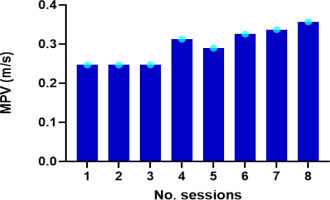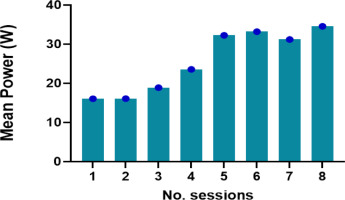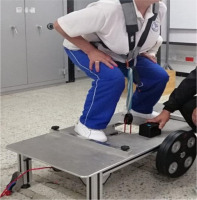Introduction
Ageing is a biological and physiological process that causes deterioration of physical function and reduces quality of life [1]. The decrease in muscle due to ageing, sarcopenia [2], affects the quality of neuromuscular performance, which is important for maintaining bodily function and health. Therefore, there is a need for various alternatives to address this condition, which progresses with age [3].
The deterioration in the performance of older adults results in a loss of strength [4] and muscle fibre atrophy [5, 6] through a catabolic environment of cellular order [7] that alters regenerative capacity. Such changes highlight the importance of alternative nonpharmacologi- cal strategies to counteract these muscular alterations and improve structural, mechanical, and tensional conditions [8] in older adults, promoting their health and reducing the harmful effects of deterioration.
Among the interventions that promote functional capacity in older adults (strength training, eccentric exercises), flywheel training has been shown [9-11] to enhance neuromuscular activity by increasing eccentric influence [12], postural stability [13] and power (jumping force) [14], as well as reducing the likelihood of falls [15].
Equally important is the ability of flywheel machines to provide constant muscle tension and high levels of fibrillar activation during the deceleration phase [10], which would be beneficial for enhancing physical function. Furthermore, enhancing physical function and preserving muscle mass during the ageing process is equally important [16] for improving the quality of life in older adults [17]. Therefore, recognising the significance of maintaining functionality in older adults [18], this study determined the effects of squat training using a flywheel on body composition and neuromuscular performance, such as power and velocity, in older adult women. The hypothesis was that the programme would improve jump performance variables (peak power) and body composition. Additionally, we evaluated the correlation between squat flywheel training power and jumping power.
Material and methods
Participants
Fourteen older women volunteered [experimental group (EXP), n = 7; control group (CON), n = 7] to participate in this study, with the EXP group undertaking flywheel resistance exercise training (FWRET). An InBody 270 digital scale (InBody, Seoul, South Korea) measured body mass, body fat, and average lean muscle weight, while a stadiometer (Seca Corp., CA, USA) measured height (table 1). All participants were familiar with the monitoring and testing procedures.
Table 1
Body composition characteristics in older women
A priori analysis employed G Power 3.1 [19] to test the differences between two groups, with repeated measures, within-between interaction, a medium effect size (f = 0.39) [20], an alpha of 0.05, and a repeated measures correlation of 0.50 used. the results indicated that at least 24 participants were needed to achieve a power of 0.80, though this pilot study recruited fewer people (n = 14).
All participants completed one session per week for eight weeks, with those who underwent FWRET given a 10-minute break between exercises. External workload assessments of neuromuscular performance [countermovement jump (CMJ)] were tracked at the beginning and end of the study using an inertial sensor system (GYKO). Additionally, data was collected during each FWRET session, analysing variables such as mean propulsive velocity (MPV) and power during each concentric and eccentric movement. The information was gathered using Smartcoach™ software v.3.1.8.0 and a sports device (Europe AB, Stockholm, Sweden). The research staff provided motivational verbal encouragement during all repetitions.
Procedures
Participants underwent two familiarisation sessions before starting the training program, which included a review of safety guidelines, adjusting a harness to fit leg length, and practising with the RSP Squat training device (RSP, Pontevedra, Spain; Figure 1). During each training session, participants completed four sets of fourteen repetitions, including two at the beginning of each exercise to start the squat flywheel movement, followed by twelve maximal bilateral repetitions. The device was initially equipped with a flywheel with a moment of inertia of 374.68 kg/cm2 (with no masses) in the first week. In the second week, the flywheel was modified to have a moment of inertia of 449.616 kg/ cm2 by adding two masses, following the procedures outlined in previous studies [21]. Finally, participants engaged in four-mass (524.55 kg/cm2) flywheel training during weeks three to eight.
Participants accelerated the flywheel during the concentric action and decelerated it during the eccentric action at the end of each set. There was a three- minute rest period between sets. Real-time feedback on concentric and eccentric actions was provided by Smartcoach™ sports software (v.3.1.8.0) and a device (Europe AB, Stockholm, Sweden). The research staff offered motivational verbal encouragement throughout the session. Outcome measures were assessed at the beginning and end of the intervention period by research staff blinded to group assignment.
Statistical analysis
Anthropometric and performance data are presented as the mean and standard deviation (SD). The Shapiro- Wilk test assessed the normality of the groups and determined if there was a statistically significant relationship between body composition and neuromuscular performance. A student’s t-test, with a 95% confidence interval (Cl), and a repeated measures analysis of variance (RM-ANOVA) assessed group differences. Pearson’s correlation examined the correlation between significant variables. According to Cohen’s d [22], effect size (ES) was categorized as > 0.2 (small), > 0.5 (moderate), or > 0.8 (large). All statistical tests employed JASP 0.18.1.0 software (Amsterdam, Netherlands).
Results
All participants completed every session, achieving a 100% compliance rate. There were no significant differences between groups for body weight (p = 0.17), body mass index (p = 0.18), body fat (p = 0.25), kilocalories (p = 0.30), biological age (p = 0.81), and visceral fat (p = 0.17) (Table 2).
Table 2
Effects of the flywheel training program on body composition in older adult women
[i] BW - body weight, BMI - body mass index, BF - body fat, Cl - confidence interval, M - % of muscle, RM KCAL - metabolic rate/kilocalories, BA - biological age, VF - visceral fat. DIF - between-group differences statistically significant differences - p < 0.05, within - group differences, one-way ANOVA p-value (composition factor), between-group differences
Table 3 shows pre-test and post-test mean group values (with a 95% Cl) for jump variables. Within-group analyses showed significantly better performance by the EXP in peak flight time (PFT, p < 0.001), peak contact time (PCT, p < 0.001), peak concentric duration (PCD, p = 0.015), peak concentric work (PCW,p < 0.001), peak jump height (PJH, p < 0.001), peak maximum velocity (PMV, p = 0.007) and peak rate force development (PRFD, p < 0.001) jump variables Between- groups analyses showed no improvements in the EXP over the CON. Mean power also increased in the EXP, with changes related to the PFT (r = 0.69, p < 0.05), PCD (r = 0.67, p < 0.05), peak eccentric work (PEW; r = 0.75, p < 0.05), PCW (r = 0.57, p < 0.05), PJH (r = 0.66, p < 0.05), PMV (r = 0.59, p < 0.05), peak maximum power (PMP; r = 0.63, p < 0.05), peak maximum force (PMF; r = 0.54, p < 0.05), RFD; r = 0.52 , p < 0.05) and peak time to maximum force (PTMF; r = 0.89, p < 0.05) jump variables.
Table 3
Effects of the flywheel training program on jump performance in older adult women
[i] CON - control group, EXP - experimental group, PFT - peak flight time, PCT - peak contact time, PED - peak eccentric duration, PCD - peak concentric duration, PEW - peak eccentric work, PCW - peak concentric work, PJH - peak jump height, PMV - peak maximum velocity, PMP - peak maximum power, PMF - peak maximum force, PRFD - peak rate force development, PTMF - peak time to maximum force statistically significant differences (p < 0.05), ES - effect size, within - group differences, one-way ANOVA p-value (composition factor), between-group differences
Flywheel device power assessment
Figure 2 shows that mean (0.29 ± 0.04) MPV (0.246 to 0.357 m/s) increased in the EXP as the number of sessions increased. Figure 3 shows that mean power (25.99 ± 7.91 W) also increased (16.07 to 34.58 W) in the EXP as the number of sessions increased. Both MPV and mean power were significantly higher following the intervention compared to the baseline data. Participants in the EXP saw a 59% increase in MPV and a 66.7% increase in mean power over the eight weeks.
Figure 2
Mean propulsive velocity. A record of each training session during the eight weeks in the experimental group

Figure 3
Mean power. A record of each training session during the eight weeks in the experimental group

As outlined in Table 4, Pearson’s correlation coefficients between changes in jumping and mean power variables after the intervention were significant for PFT (r2 = 0.69, p = 0.18), PCD (r2 = 0.67, p = 0.19), PEW (r2 = 0.75, p = 0.014), PCW (r2 = 0.57, p = 0.049), jump height (r2 = 0.66, p = 0.20), PMV (r2 = 0.59, p = 0.049), PMP (r2 = 0.63, p = 0.049), PMF (r2 = 0.54, p = 0.05), RFD (r2 = 0.52, p = 0.048) and PTMF (r2 = 0.89, p = 0.049).
Table 4
Pearson’s correlation coefficient between jumping variables and mean power
Discussion
This study evaluated the effects of squat training using flywheel equipment on body composition and neuromuscular performance in older women. We found that the changes in body composition variables were insignificant after the intervention protocol [5, 16, 18].
Although strength training can help counteract deficiencies related to the loss of muscle mass, it must meet certain parameters of intensity and frequency greater than once a week. Indeed, the present study found no body composition modifications using a once- per-week protocol. However, jump performance improved significantly after eight sessions of squat training using flywheel equipment, perhaps due to the 10-minute break [23] and increased neuromuscular order stimuli that allowed for greater recruitment of motor fibres [24]. the changes in CMJ measurements may be due to previous negative neuromuscular effects, such as decreased contraction response and velocity, caused by the ageing process [24-26]. Additionally, there may have been a reduction in motor unit discharge frequency [27] and altered spinal and cortical excitability [28].
The main finding of the research was that the FWRET intervention elicited significant and positive changes in the contractile capacity of the lower limbs. The changes were likely due to the eccentric phase [16, 28], which is overloaded by inertia, generating tension accumulation and leading to more effort and better work efficiency [15, 29]. The study findings show that an increase in negative deceleration work [30, 31] favoured acceleration performance in jump variables [32], such as flight time, contact time, concentric duration, concentric work, jump height, maximum speed [33] and RFD [34], confirming the study hypothesis.
Squat flywheel actions allow for the preferential recruitment of higher threshold motor units and cortical activity [35], improving the kinetic efficiency of the musculotendinous unit as a physiological adaptation through training. This results in a practical tool that enhances RFD and muscle power production [36, 37].
The results are significant as they demonstrated improved explosive muscle strength capacity after eight weeks of FWRET. Participants in the EXP showed an increase in MPV in the lower limbs (from 0.24 m/s to 0.40 m/s - 59%) and mean power (from 16.07 W to 48.28 W - 66.7%). Such improved jump ability [38-40] was likely due to better muscular performance between the eccentric [41] and concentric contractions of the squat.
Flywheel training provides a positive alternative to the detrimental effects of ageing [42], such as decreased neural activation frequency and reduced strength development capacity, resulting in improved performance in jump tests and daily living activities [43].
Similarly, using flywheel machines during squat exercises demonstrates how tensional muscle mechanical performance can be improved through eccentric (negative) contractions. This aims to enhance strength [43], balance [13] and power [44-46], highlighting the muscle-tendon action [46, 47].
Flywheel training exercises may provide benefits in terms of functional adaptation, neuromuscular activation [48], structural improvement [49], contractile capacity, and muscle elongation in the older adult population [30]. Overall, the mechanics of eccentric squat actions could help mitigate changes associated with the ageing process and improve an individual’s quality of life [50]. This is achieved by preserving muscle contraction mechanisms through better neural stimulation as a protective health factor [42, 50].
Limitations
The main limitation of this study was its small sample size (n = 14), highlighting the need for the recruitment of a larger sample in the future.
Conclusions
Despite the caution that should be taken in interpreting our results, the current pilot study confirms that squat training using flywheel equipment could significantly increase explosive strength capacity in older women. The findings could provide a strategy with substantial contributions to maintaining muscle and contractile function, improving functional independence, and enhancing the quality of life in older people.



